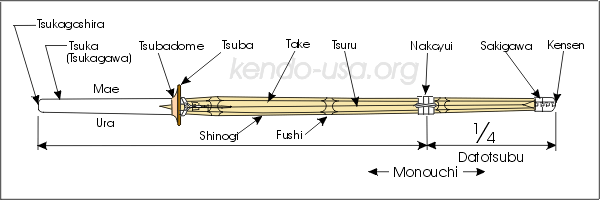The shinai is the fencing foil of kendo. It allows a kendoist to practice freely without fear of serious injury to oneself or others. The modern shinai is constructed of four staves of bamboo fitted together into a cylinder. It is held together by leather and a string.
The first shinai were made of split bamboo and completely covered in a cloth or leather bag known as a fukuro shinai or bag shinai. Shinai were of many different lengths and weights. The name shinai comes from the verb shinau meaning to bend or be flexible. The shinai of today have regulations for length and weight.
The shinai is made from bamboo that is cut from the bottom of the culm (stem) about 4" (10cm) above ground. The shinai will have 5 nodes (fushi). Like the hakama pleats each of the fushi has a meaning. The stem is split vertically into 6 to 8 pieces. The bamboo is dried, 4 pieces selected and straightened. The pieces are then planed and shaped into a shinai.
Shinai Terminology:
Take, Yotsuwari Take or Takenomi- 4 bamboo staves
Fushi - node
Tsuka - handle
Tsukagawa - leather handle
Tsukagashira - end of handle
Nakayui - leather binding
Sakigawa - leather tip
Kensen - tip of sword
Tsuru - string
Sakushingomu or Sakigomu - rubber tip or plastic tip inside the sakigawa
Chigiri - metal square in the handle
Tsuba - handguard
Tsubadome - rubber stopper for handguard
Shinogi - side of the shinai
Datotsubu - valid strike area
Monouchi - part of the blade of the sword that cuts the best
Mae - front side
Ura - back side


Copyright © www.kendo-usa.org

